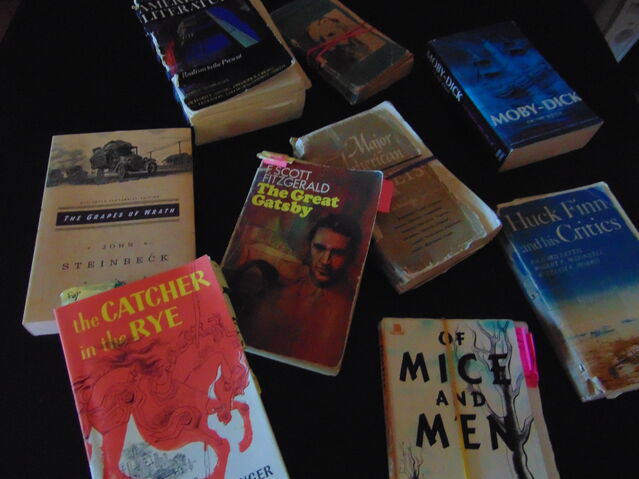Relationships
Banned Books Can Enable Us to See Life Through a New Lens
A Personal Perspective: Insightful voices are silenced when books are banned.
Posted November 29, 2022 Reviewed by Michelle Quirk
Key points
- Stories of the poor and homeless and of marginalized people are among the most banned titles.
- Books are often banned for superficial reasons, while their deeper messages are ignored.
- Many banned books can inspire us to build more humane and just societies.
Anyone who visits a university English department will eventually see a professor carrying a patched-up novel held together by scotch tape and rubber bands. Those of us who are in the profession know this is the professor’s “teaching copy,” the one they have read to their classes for several decades.
This is certainly the case with my teaching copies. I refer to them as my “Old Friends” because those frayed, beaten-up books hold so many memories of the insights their authors communicated to me through their skillful storytelling. These classics yield their treasures gradually over years of reading and rereading. In time, they have become members of my intellectual family that I carry through life.
Cherished Novels
Recently, I spotted several lists of the most banned books in American literature, and I realized my “Old Friends” were on most of those lists. I asked myself the obvious question: “Why are the titles I love to teach on the banned books list?” Rather than consult more lists, I decided instead to share the reasons why I still cherish and teach those novels.
Mark Twain’s The Adventures of Huckleberry Finn is one of the most banned books in American literature. The repeated use of the “n” word is one reason. However, Black scholars are among its most ardent defenders. They commend Twain for trying to accurately reproduce the dialects in the novel. Twain’s love of dialects was inspired in part by the slaves he visited on his uncle’s farm. From them, he learned that the “manner” of telling a story was more important than the “matter.”
Ernest Hemingway was later to state that Twain’s novel is “the best book we’ve had. All American writing comes from that.” What exactly Hemingway meant is open to debate, but he certainly understood that Twain’s novel was a huge step forward in the development of American literature. Banning Twain’s novel also bans the first American novel to break with the English language we had inherited from Great Britain. Instead, Twain used native dialects to help build an American literary tradition. Isn’t that an accomplishment we should cherish?
Jim, an escaped slave and Huck’s companion, wants only to reunite his family: a noble goal when many of the other characters in the story are motivated by human greed, not family love and loyalty. Jim also becomes somewhat of a father to Huck, whose own father Pap was a drunken, racist, child beater. I encourage my students to think of the novel as an American epic as Huck and Jim, symbols of white and Black America, try to overcome their differences while they journey down the Mississippi River together. One of the many lessons in this novel is that white and Black Americans can find mutual understanding and build a society together—even a society as small as a raft.
John Steinbeck’s The Grapes of Wrath and Of Mice and Men are also on many of these banned books lists. Both novels describe the struggles of homeless Americans on a journey to find the elusive place where they can build a better life for themselves. On their journeys, however, what they meet are many people who exploit them as a cheap source of labor. The Joad family travels from Oklahoma to California in an old truck as they look for work and struggle to find enough to eat. The novel is a tribute to the family bonds that hold the Joads together as they confront insurmountable odds against their very existences. The novel is also an invaluable source for teaching younger Americans about the greatest economic catastrophe in American history.
Lennie and George in Steinbeck’s Of Mice and Men have their own dream of a home where they can settle down and end their aimless wanderings. Yet, that final destination remains elusive and forever in the distance—albeit it still provides hope in a world without much hope. The dream ends when George is forced to execute his old friend Lennie before he falls into the hands of a vigilante posse. Yes, Lennie is guilty of a serious, albeit unintentional, crime. However, the thrust of the book is on how George and Lennie try to build a friendship and share their dreams even as they wander through life without any real hope of a better future. In spite of their failure to purchase a home and settle down, Lennie and George extend the American Dream into the Great Depression of the 1930s.
J. D. Salinger’s The Catcher in the Rye chronicles the experiences of young Holden Caulfield, a socially inept teenager who struggles with every relationship in his life—except for his young sister Phoebe, whom he worships. Holden’s parents are distant and unreachable, almost invisible in the novel. He has to contend with the death of his brother, a loss that sends him into a spiraling descent of depression that eventually puts him in a mental hospital. Before his breakdown, Holden satirizes almost everything and everyone he refers to as “phonies” who are incapable of real love and affection.
The novel explores the values of a superficial, materialistic culture that has lost the ability to form real, lasting relationships. It also chronicles a teenager’s deteriorating mental condition as he plunges through one stage of depression after another—until he has a final breakdown. The novel, from whatever perspective it is viewed, encourages readers to understand the traumas of those young misfits and outcasts who can never form lasting relationships at the most vulnerable stage in their lives.
F. Scott Fitzgerald’s The Great Gatsby, often rated by critics and scholars as the best American novel ever written, has also taken a beating from the book banners. They accuse Fitzgerald of belaboring his presentation of a wealthy, irresponsible society that engages in meaningless affairs (but no graphic sex scenes), drunken parties, financial corruption, wild and reckless automobile rides, and other such activities. Fitzgerald presents this bored, wealthy class as indifferent to the suffering of the poor. At the risk of being overly simplistic, The Great Gatsby exposes a corrupted 1920s-era American Dream and all who live by its self-serving, overly materialistic values.
Challenging Us to See Things Differently
Great books often make us uncomfortable because they expose old stereotypes and encourage us to see life through a new lens. However, they also challenge us to rethink bias, bigotry, racism, superficial stereotyping of people, negative attitudes toward the poor and homeless, and other such issues. That is why they are classics.
There are many authors like myself who would welcome being included on these lists of banned books because they reexamine what we are as a society and how we judge others around us. These books penetrate a little deeper into human life and its many manifestations. Those who ban them are only banning the insights that can help us build a more humane and just society.

References
Mark Twain, “The Adventures of Huckleberry Finn” (1884)
Mark Twain, “How to Tell a Story” (1895)
F. Scott Fitzgerald, “The Great Gatsby” (1925)
John Steinbeck, “Of Mice and Men” (1937)
John Steinbeck “The Grapes of Wrath” (1939)
J. D. Salinger, “The Catcher in the Rye” (1951)




